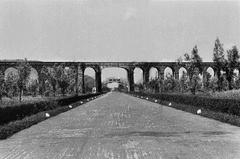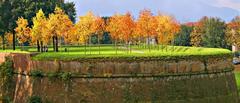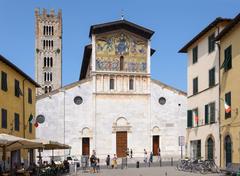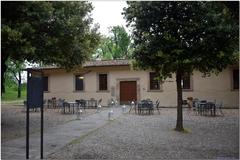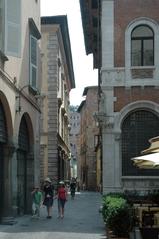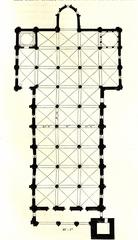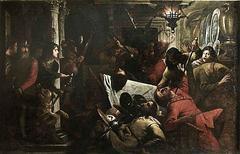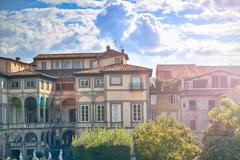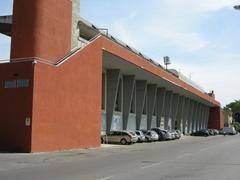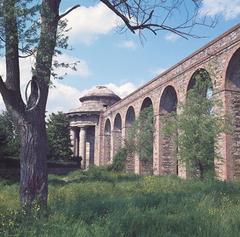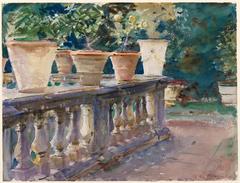Paolo Cresci Museum For The History Of The Italian Emigration
Paolo Cresci Museum: Visiting Hours, Tickets, and Lucca Historical Sites Guide
Date: 04/07/2025
Introduction
The Paolo Cresci Museum for the History of Italian Emigration in Lucca stands as a vital cultural institution, offering deep insight into one of the largest migratory movements in modern history. From the mid-19th century through the 1960s, over 27 million Italians left their homeland in search of economic opportunity, profoundly shaping both Italy’s national identity and the global diaspora. The museum, housed in the historic Cappellina Santa Maria della Misericordia within the Palazzo Ducale, presents an immersive narrative of these emigrants’ journeys, from departure and perilous voyages to adaptation and community-building in new lands.
Founded on the extensive personal archive of Paolo Cresci—a Florentine scholar and photographer—the museum preserves more than 15,000 artifacts, including letters, passports, photographs, and everyday objects. Through its exhibitions, multimedia installations, and educational programs, the Paolo Cresci Museum connects history enthusiasts, descendants of emigrants, and casual travelers with the lived experiences of Italian migration, encouraging reflection on how these stories continue to resonate today.
For the latest updates, practical visitor information, and special events, consult the official museum website or affiliated platforms (Museo Paolo Cresci, Puccini Lands).
Historical Context of Italian Emigration (1860–1960)
Between 1860 and the 1960s, a combination of economic hardship, political instability, and social upheaval drove millions of Italians—especially from southern regions like Calabria, Sicily, and Campania—to seek new lives abroad. Primary destinations included the United States, Argentina, Brazil, Australia, and other parts of Europe (Museo Paolo Cresci, Two Parts Italy). The journey was often arduous, with migrants braving long sea voyages and uncertain prospects.
Upon arrival, Italian emigrants typically found work in labor-intensive sectors such as construction, agriculture, and mining. They faced significant challenges, including language barriers and discrimination, but maintained cultural ties through traditions, remittances, and correspondence. The museum’s collection of letters, diaries, and family photographs offers poignant testimony of this era (Musei Provinciali Lucca).
Over time, Italian government policy evolved from encouraging emigration as a way to relieve domestic pressures to regulating it amid concerns about depopulation. The movement declined in the mid-20th century, paralleling global economic changes and stricter immigration policies abroad.
The Paolo Cresci Museum: Origins, Collection, and Location
Paolo Cresci: The Vision Behind the Museum
Paolo Cresci (1943–1997), a Florentine scholar and scientific photographer, began collecting documents, photos, and artifacts relating to Italian emigration in the 1970s. By the time of his death, Cresci had assembled over 15,000 items, forming Italy’s most comprehensive archive on this subject (Lucca.com). In 2002, the Province of Lucca acquired Cresci’s archive, establishing the Paolo Cresci Foundation to manage the museum and continue its mission (Musei Provinciali Lucca).
Museum Setting: A Historic Chapel in the Palazzo Ducale
Located in the Chapel of Santa Maria della Misericordia within Lucca’s Palazzo Ducale, the museum provides a unique and evocative setting for its exhibitions. The chapel, dating back to at least 1131, features original frescoes and architectural elements, enhancing the visitor experience (Fondazione Paolo Cresci).
Exhibitions and Collections
Permanent Displays
The museum’s permanent exhibition is organized thematically, following the emigrant’s journey: decision to leave, preparations, voyage, arrival, adaptation, and maintaining ties with Italy (Dove a Lucca). Highlights include:
- Passports and Travel Documents: Illustrating the bureaucratic process of migration.
- Personal Letters and Diaries: Offering insights into migrants’ hopes, fears, and family bonds.
- Photographs: Capturing departure scenes, shipboard life, and new communities abroad.
- Everyday Artifacts: Trunks, religious icons, clothing, and tools reflecting migrants’ material and spiritual lives.
- Printed Materials: Newspapers and books that sustained Italian culture overseas.
Temporary Exhibitions
Regularly changing exhibits address specific themes such as women in migration, Italian communities in the Americas, and contemporary migration issues. These often include contemporary art and collaborations with other museums.
Multimedia and Interactive Features
The museum incorporates multimedia installations, including historical footage, oral histories, and interactive displays. Visitors can access digital archives, search emigrant records, and view interviews with descendants, making the experience participatory and personal (Visit Tuscany).
Visitor Information
Location and Directions
- Address: Cappellina Santa Maria della Misericordia, Palazzo Ducale, Via Vittorio Emanuele, n. 3, 55100 Lucca, Italy.
- How to Get There: Centrally located within Lucca’s historic city walls, the museum is easily reached on foot from the train station (15-minute walk) or by bus from Piazzale Verdi.
Visiting Hours
- Summer (May 1 – September 30): 10:00 – 12:30 and 15:00 – 18:30, closed Mondays.
- Winter (October 1 – April 30): 9:30 – 12:30 and 14:30 – 17:30, closed Mondays.
- Special Events: Extended hours during citywide festivals; check the official website for updates.
Ticket Information
- Admission: Entry is free; no advance booking required.
- Guided Tours: Available by request in Italian and other languages.
Accessibility
- Fully wheelchair accessible, with ramps, elevators, and staff assistance as needed.
- Multilingual information panels and audio guides are available for international visitors.
Amenities
- Information Desk: Maps, assistance, and research support.
- Research Assistance: Genealogy and migration research support for visitors.
- Nearby Parking: Paid parking available at Lorenzini and Cittadella garages.
Educational and Cultural Programs
Guided Tours and Educational Outreach
The museum offers guided tours, educational workshops, and school programs. These initiatives emphasize migration’s social, economic, and cultural impact, suitable for visitors of all ages.
Community Engagement and Special Events
The museum collaborates with local schools, diaspora organizations, and cultural partners to host lectures, conferences, commemorative events, and book launches. It actively participates in citywide events such as “Lucca Notte Bianca,” extending its reach to broader audiences (Fondazione Paolo Cresci - News).
Research and Family History
On-site and online digital archives are available for genealogists and descendants seeking to trace their Italian roots (Museo Emigrazione Italiana). Staff are available to assist with research queries.
Unique Features and Cultural Significance
- A Living Archive: The museum continues to expand its collections through community donations and research.
- Civic and Educational Mission: By linking historical and contemporary migration narratives, the museum promotes tolerance, intercultural dialogue, and social reflection.
- Artistic Vision: The museum’s logo, inspired by Jean Michel Folon’s art, features a suitcase symbolizing the poetic journey of migration.
Travel Tips and Nearby Attractions
- Best Time to Visit: Spring and fall for mild weather and fewer crowds.
- Nearby Sites: Guinigi Tower, Lucca Cathedral, and the Renaissance city walls—all within walking distance (Puccini Lands Nearby Attractions).
- Local Cuisine: Enjoy Tuscan specialties at nearby cafes and restaurants.
Frequently Asked Questions (FAQ)
Q: What are the museum’s opening hours?
A: Summer: 10:00–12:30 & 15:00–18:30, Winter: 9:30–12:30 & 14:30–17:30, closed Mondays.
Q: Is there an admission fee?
A: Admission is free.
Q: Is the museum accessible?
A: Yes, fully accessible for visitors with disabilities.
Q: Are guided tours available?
A: Yes, by request in multiple languages.
Q: Can I conduct family history research at the museum?
A: Yes, digital archives and staff support are available.
Q: What other attractions are nearby?
A: Guinigi Tower, Lucca Cathedral, and the city walls.
Conclusion and Plan Your Visit
The Paolo Cresci Museum is more than a historical site—it is a vibrant center for cultural preservation, research, and community engagement. With its free admission, central location, and engaging exhibits, it is an essential destination for travelers exploring Lucca’s heritage. To plan your visit, consult the latest updates on the official museum website or Puccini Lands, and consider downloading the Audiala app for audio guides and additional content.
Stay connected by subscribing to the museum’s newsletter, following their social media channels, and exploring related articles on our website.
Sources
- Discover the Paolo Cresci Museum in Lucca: History, Visiting Hours, Tickets & Travel Tips, 2023, Museo Paolo Cresci (Museo Paolo Cresci)
- Visiting the Paolo Cresci Museum in Lucca: Hours, Tickets, and Italian Emigration History, 2024, Puccini Lands (Puccini Lands)
- Visiting the Paolo Cresci Museum in Lucca: Hours, Exhibitions, and Visitor Guide, 2023, Dove a Lucca (Dove a Lucca)
- Visiting the Paolo Cresci Museum in Lucca: Hours, Tickets, and Historical Insights, 2024, Fondazione Paolo Cresci (Fondazione Paolo Cresci)
